A shy teenager unexpectedly named heir to Julius Caesar, Octavian remade Rome without claiming a crown. How did an 18‑year‑old outsider convert fragile legitimacy into lasting power? This article follows his ascent from adoption to authority and asks whether he restored a republic, invented a monarchy, or engineered both at once.
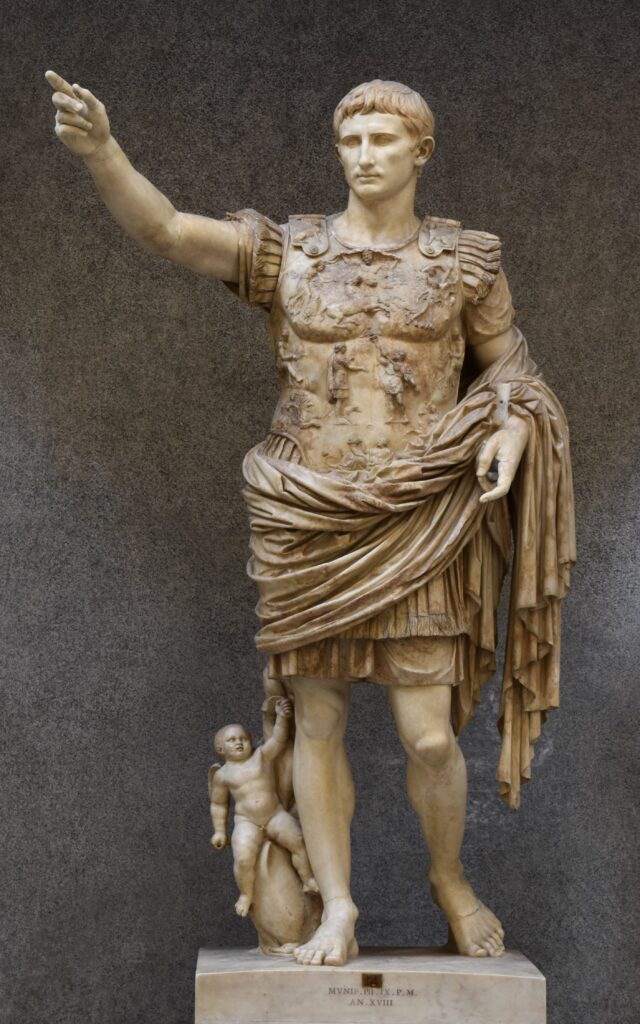
Stage the Break and the Bargain
On a spring day in 44 av. J.-C., a slender youth landed at Brundisium, clutching a letter and a dangerous inheritance. Gaius Octavius, freshly renamed Gaius Julius Caesar Octavianus by testament, had learned that Caesar—murdered weeks earlier—had adopted him and bequeathed his name, wealth, and enemies. Rome reeled; the Senate was nervous; legions watched. Octavian understood two imperatives: avenge Caesar and survive Caesar. He moved quietly, recruited veterans who revered the dead dictator, paid out the promised donatives with borrowed funds, and addressed the city as if nothing—yet everything—had changed.
This article argues that Octavian became Augustus by combining three levers: meticulous legal choreography to tame the Senate and assemblies, relentless military and patronage networks centered on veterans and allies like Agrippa, and a cultural revolution that made his power feel traditional. The plan below follows this arc. First, the background to his improbable claim. Then the documented story from Mutina to Actium and the “settlements.” Next, an analysis of his techniques of rule. We turn to historiographical disputes over violence, ideology, and design. Finally, we assess consequences from the Pax Romana to an imperial political imaginary that outlived its founder.
Trace the Origins and the Inheritance
Octavian’s origins shaped his methods. Born 63 av. J.-C. to a moderately distinguished equestrian family, he grew up outside the core of senatorial clans. His mother, Atia, was Julius Caesar’s niece; the connection offered proximity, not inevitability. Caesar noticed the boy’s composure during the Ludi Apollinares and later invited him to join the Spanish campaign in 46–45 av. J.-C. When shipwreck and a stubborn march to the front failed to deter him, Caesar admired the resolve.
The political world Octavian entered in 44 av. J.-C. was broken. The assassination created not a clear choice between liberty and tyranny but a vacuum of norms. Consuls hesitated. The Senate oscillated between reconciliation and revenge. Mark Antony, consul and Caesar’s ally, controlled the city’s pulse but misread the crowd’s grief. When Antony’s funeral oration sparked riots, using Caesar’s bloodied toga as a prop, he turned popular sympathy into a political weapon he could not fully wield.
Octavian did something subtler. He adopted Caesar’s name, declared himself filius, and promised to fulfill the will’s commitments. He avoided inflammatory speeches, leaned on personal meetings with veterans, and courted the Senate without surrendering leverage. Crucially, he learned to translate emotion into institution: grief into donatives, loyalty into legions, legitimacy into legal forms.
Rome’s constitutional machinery provided tools and traps. Sulla’s dictatorship had shown how proscriptions and land confiscations could realign politics. Pompey’s and Caesar’s extraordinary commands had expanded the vocabulary of legal exception. Octavian absorbed the lesson: power must be clothed in law, even if law is tailored for power. The result would not be a coup at a single moment, but an accretion of precedent, oath, and ritual that made monarchy look like the Republic’s most traditional act.
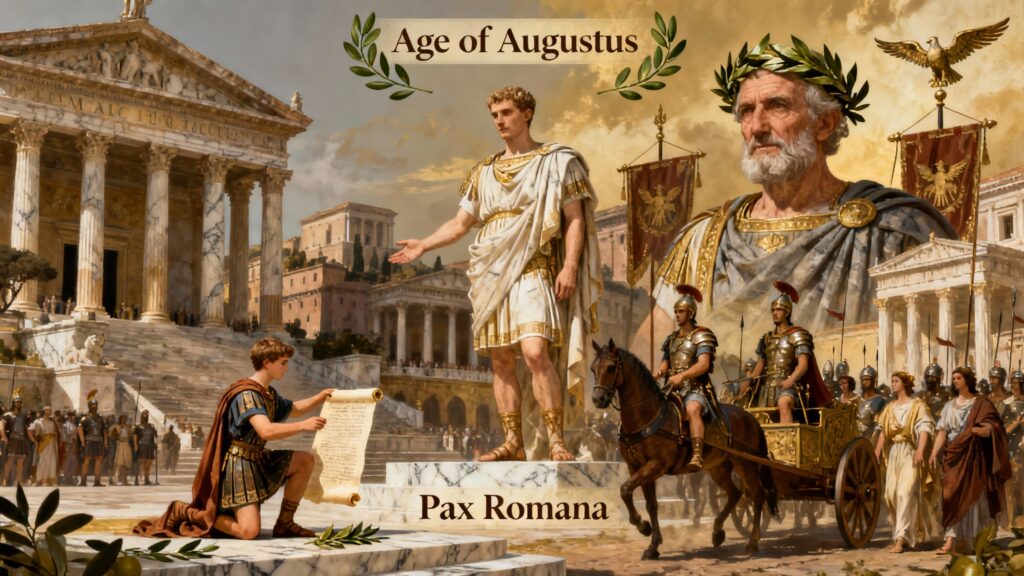
Recount the Campaigns and Settlements
After a brief alignment with the Senate against Antony at Mutina in 43 av. J.-C., Octavian pivoted. He refused to be a tool for defenders of a moribund order. With legions behind him, he marched on Rome, secured the consulship (43 av. J.-C.), and negotiated the Second Triumvirate with Antony and Lepidus, legalizing extraordinary powers to “stabilize the state.” The cost was public and personal: proscriptions that executed rivals and financed armies. The orator Cicero fell, his head and hands displayed—an early reminder that Octavian’s mild manner had iron edges.
At Philippi in 42 av. J.-C., the triumvirs defeated Brutus and Cassius. Antony took the East; Lepidus kept Africa; Octavian inherited the scarcely grateful veterans needing land in Italy. The Perusine War (41–40 av. J.-C.) punished resistance, sent messages about clemency’s limits, and tightened control. A temporary reconciliation with Antony at Brundisium (40 av. J.-C.), sealed by Antony’s marriage to Octavian’s sister Octavia, kept the façade of unity.
The sea carried the next tests.
Sextus Pompey seized Sicily and threatened grain supplies. Agrippa, Octavian’s indispensable lieutenant, trained a fleet, built the harbor at Portus Iulius, and crushed Sextus at Naulochus (36 av. J.-C.). Lepidus tried to exploit the moment; his troops defected; Octavian stripped him of power and spared his life—a mixture of ruthlessness and restraint that would become pattern.
The stage narrowed to two men.
Antony’s alliance with Cleopatra alienated Roman sentiment; his Parthian campaign faltered. Octavian mounted a coordinated political and military offensive. He read Antony’s will to the Senate, highlighting bequests to Cleopatra’s children and plans for burial in Alexandria—facts and insinuations aligned. The Senate declared war on Cleopatra, not Antony, preserving Roman fraternity while isolating an “eastern queen.” At Actium (31 av. J.-C.), Agrippa’s superior maneuvering carried the day. Antony and Cleopatra fled; Alexandria fell in 30 av. J.-C.; their suicides ended a civil generation.
Octavian returned to Rome in triumph (29 av. J.-C.), staged three triumphs, closed the doors of Janus—sign of peace—more than once, and began a decade-long negotiation with tradition. In the First Settlement (27 av. J.-C.), he surrendered exceptional commands to the Senate while receiving the name “Augustus,” the aura of the sacred, and a long proconsular command over key provinces where most legions lay. He styled himself princeps, the “first among citizens,” not rex. The Second Settlement (23 av. J.-C.) solved constitutional fragility: Augustus resigned the consulship yet took tribunicia potestas—tribunician power renewed annually—and imperium maius across provinces, outranking other proconsuls without flaunting office. The design allowed him to orchestrate policy, veto measures, and manage succession without the optics of dictatorship.
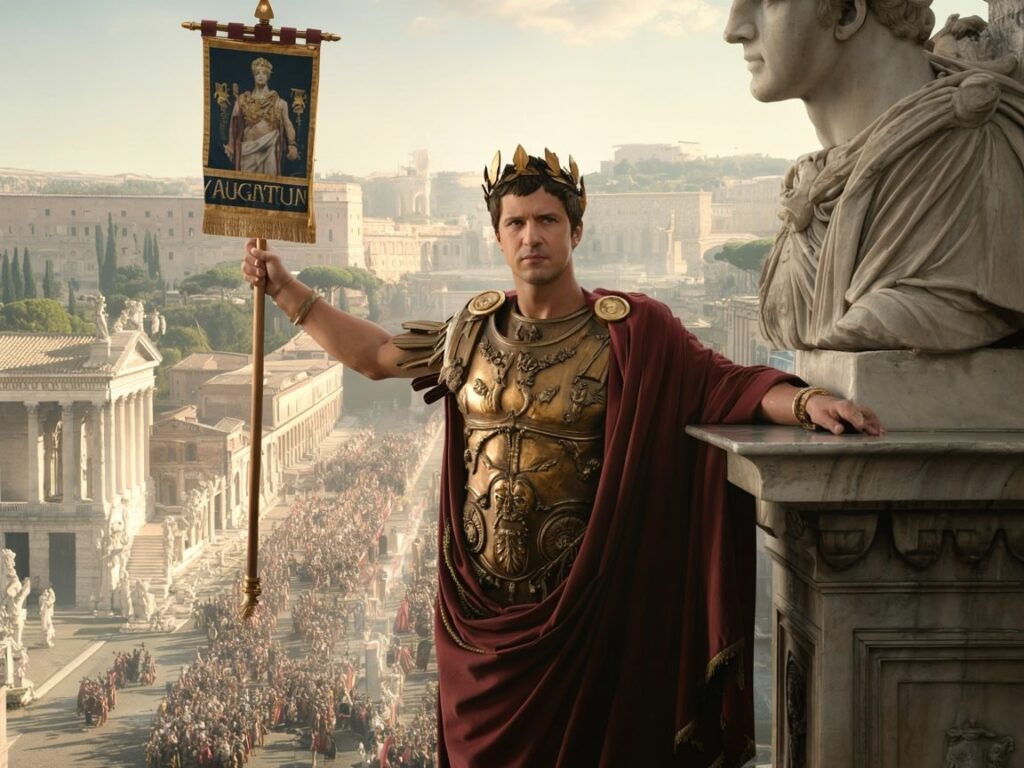
Between settlements and ceremonies, a city changed. The Temple of Apollo on the Palatine (28 av. J.-C.) linked his house to divine protection. The Ara Pacis, decreed 13 av. J.-C., dedicated 9 av. J.-C., displayed a civic procession that blended family, priesthood, and Senate into a single story of order. The Forum of Augustus, inaugurated 2 av. J.-C., arrayed past heroes as patrons of the present. Legislation targeted morals and marriage (18 av. J.-C.), praising fertility and penalizing adultery, even as the law’s most visible casualty became his own daughter, Julia, exiled 2 av. J.-C.
Abroad, settlements mattered as much as victories. In 19 av. J.-C., by diplomacy not battle, Parthia returned Roman standards lost by Crassus—a triumph of image: “I compelled the Parthians to return spoils and standards of three Roman armies” (Res Gestae). The provinces stabilized under legates; Egypt became a personal possession under a prefect. The Aerarium Militare (6 apr. J.-C.) professionalized military pay and retirement, reducing the temptation of mutinous bargains.
As years accumulated, succession loomed. Marcellus died young; Agrippa, the fixer, died 12 av. J.-C.; Gaius and Lucius, adopted heirs, died in 2 and 4 apr. J.-C. respectively. Augustus turned to Tiberius, Livia’s son, adopting him in 4 apr. J.-C. The late years saw consolidation, building, and careful staging: “I found Rome a city of brick; I leave it of marble” (Suetonius, Aug. 28.3). When he died in 14 apr. J.-C., the Senate consecrated him a god; his Res Gestae, carved on bronze and copied in provinces, told the story he wanted Rome to remember.
Analyze the Levers and the Logic
Augustus’s rise was not inevitable. It was engineered through interlocking strategies that made coercion feel consensual, innovation feel ancestral, and monopoly feel distributed.
- Legality as language. Augustus rarely claimed new offices; he accumulated powers with ancient names. Tribunician power wrapped protection of the people around his veto. Imperium maius made him a commander without a perpetual dictatorship. By rotating consulships out of his hands after 23 av. J.-C., he allowed senatorial careers to breathe, undercutting resistance while retaining the decisive instruments.
- Military as institution, not faction. Veterans made and unmade late republican leaders. Augustus settled them with land but created long-term pay structures that reduced the ad hoc bargains that fueled civil wars. The Aerarium Militare, funded by taxes and donatives, professionalized service. By keeping legions concentrated in frontier provinces under his proconsular sphere, he prevented rival power centers from maturing.
- Patronage as public policy. Agrippa was not only a general; he was a builder and administrator. Port facilities, aqueducts, and baths turned patronage into visible urban benefits. The grain supply stabilized. When everyday life improved, regime legitimacy deepened.
- Culture as constitution. Poetry became policy. Virgil’s Aeneid sacralized origins and endurance. Horace’s Carmen Saeculare (17 av. J.-C.) gave voices to a moral program of fertility and moderation. On money, stars and laurels broadcast victory and divinity in pockets and markets. Marble told a story of continuity: old gods, new order. The effect was cumulative. As Paul Zanker argued, imagery created consent by making the new look self-evidently Roman.
- Family as statecraft. The Julian line and the Claudian alliance, sealed in Augustus’s marriage to Livia (38 av. J.-C.), fused houses into dynasty while never naming a throne. Public ceremonies placed children in processions, naturalizing succession. When moral legislation struck Julia, the contradiction stung, but it also emphasized that iconography could not function without public discipline, however uneven.
- Humility as hegemony. Augustus refused a perpetual dictatorship and staged refusals of honors, even as he accepted others. He called his influence auctoritas, not potestas: “I excelled all in auctoritas, though I had no more official power than the others” (Res Gestae). The claim was paradoxical and precise. Influence, he implied, was not a formal usurpation but an earned supremacy of service, wealth, and prestige—a social fact rebranded as constitutional virtue.
- Enemies chosen carefully. He demonized Cleopatra, not Antony as a Roman, preserving civic cohesion. He spared Lepidus but neutered him, showing mercy without risk. He tolerated senatorial dignity while monopolizing command provinces. Every opponent became a lesson; every settlement, a precedent.
Causality emerges from these interactions. The memory of civil war primed elites and citizens to reward stability. Legal forms allowed collaboration without humiliation. Material improvements consolidated goodwill. Culture recalibrated expectations. By the time Augustus was “pater patriae” (2 apr. J.-C.), the title felt descriptive rather than declarative.
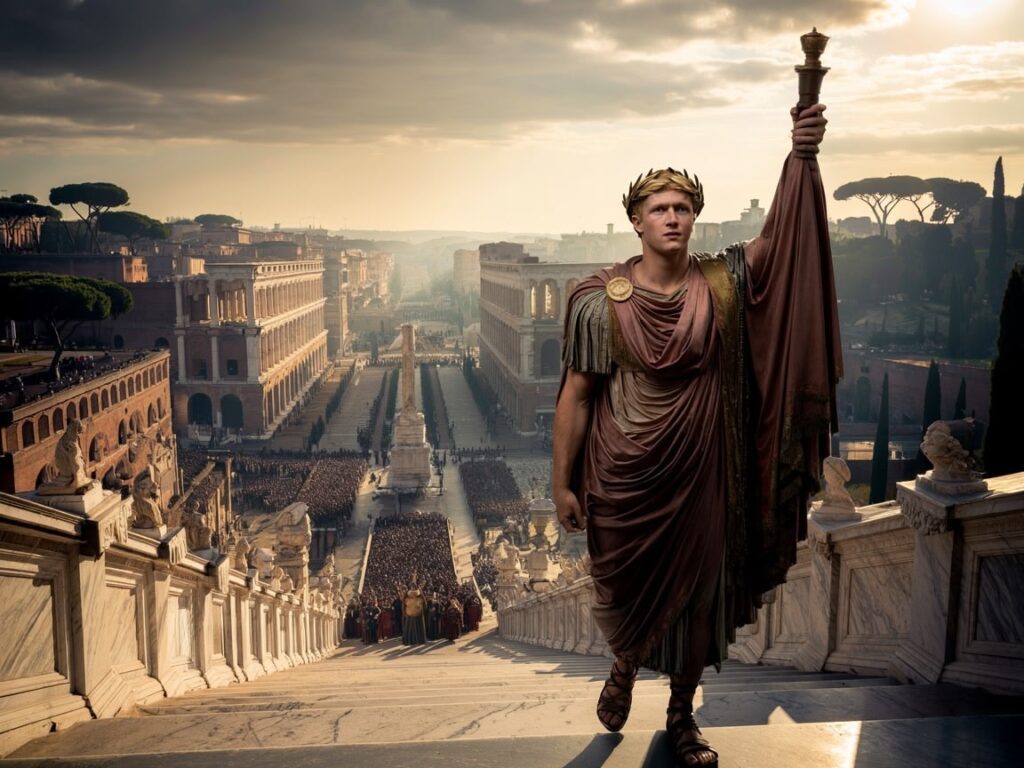
Weigh the Disputes and the Evidence
Historians divide less over facts than over frames. Three controversies dominate: the nature of the regime, the role of violence, and the question of design.
- Restoration or revolution? Ronald Syme’s “Roman Revolution” sees Augustus as the victorious leader of an oligarchic coup that replaced one elite with another under a personal monarch. The “restoration” was, in this view, rhetoric disguising power. Others, like Karl Galinsky, stress pragmatic continuity: Augustus stabilized institutions and reinvigorated religion to rebuild civic life. The truth may straddle both: a revolutionary concentration of power delivered through conservative aesthetics.
- Violence and its memory. The proscriptions (43 av. J.-C.) were brutal, funding armies and eliminating opponents. Augustus later built a politics of clemency. Was this an authentic evolution or a rhetorical pivot? Ancient voices are split. Velleius Paterculus, writing under Tiberius, praises moderation. Tacitus, with a cooler eye, notes “peace with a blood price.” The evidence shows a trajectory: early necessity, later normalization. But necessity is often retrospective justification.
- Propaganda or piety? When Horace sings of moral renewal or the Ara Pacis shows family processions, is this propaganda? In modern terms, yes. But Roman religion was a civic practice; to “propagate” was to perform communal identity. Zanker emphasizes the power of images to create a new consensus. Others, like Mary Beard, warn against reading art as mere message. A marble frieze is also a negotiation of elite self-presentation, not a unilateral broadcast.
- Eastern monarchy or Roman invention? Antony’s association with Cleopatra lent weight to accusations of “eastern despotism.” Augustus, by contrast, avoided crowns and made his house a temple to Apollo, a god of Roman self-control. Yet his regime drew on Hellenistic techniques of ruler cult, especially in provinces where cities addressed him as savior and founder. Fergus Millar highlights this reciprocity: cities used imperial cult to secure favor; the center tolerated variation.
- Was there a master plan? Some narratives write Augustus as an architect from the start. Others see opportunism refined by experience. Octavian at 18 was not yet Augustus at 40. Illnesses, deaths of heirs, and foreign crises forced adaptation. What persisted was method: conceal innovation in tradition, secure military levers, and ritualize consent.
- Livia’s influence and succession politics. Ancient gossip and modern speculation elevate Livia as strategist, even poisoner. Evidence is thin. What is clear: she was a political partner who maintained networks and stabilized the court. Tiberius’s adoption in 4 apr. J.-C. and accession in 14 apr. J.-C. demonstrate that Augustus, after losing preferred heirs, chose competence over charisma.
- Rome versus provinces. Was the regime oppressive? Provincial responses varied. Tax burdens stabilized; elites gained pathways to Roman honors; local autonomy often persisted. The absence of civil war and predictability of law made life more calculable for many. Yet Roman extraction continued. The “Pax” was peace inside an expanding frontier, not an end to conquest.
Ancient testimony must be filtered. Suetonius preserves memorable anecdotes and biased moral judgments. Cassius Dio offers a senatorial perspective from a later century. Inscriptions and coins provide checkable data: offices, titles, dates, imagery. The Res Gestae is self-serving, but its omissions are as revealing as its boasts.
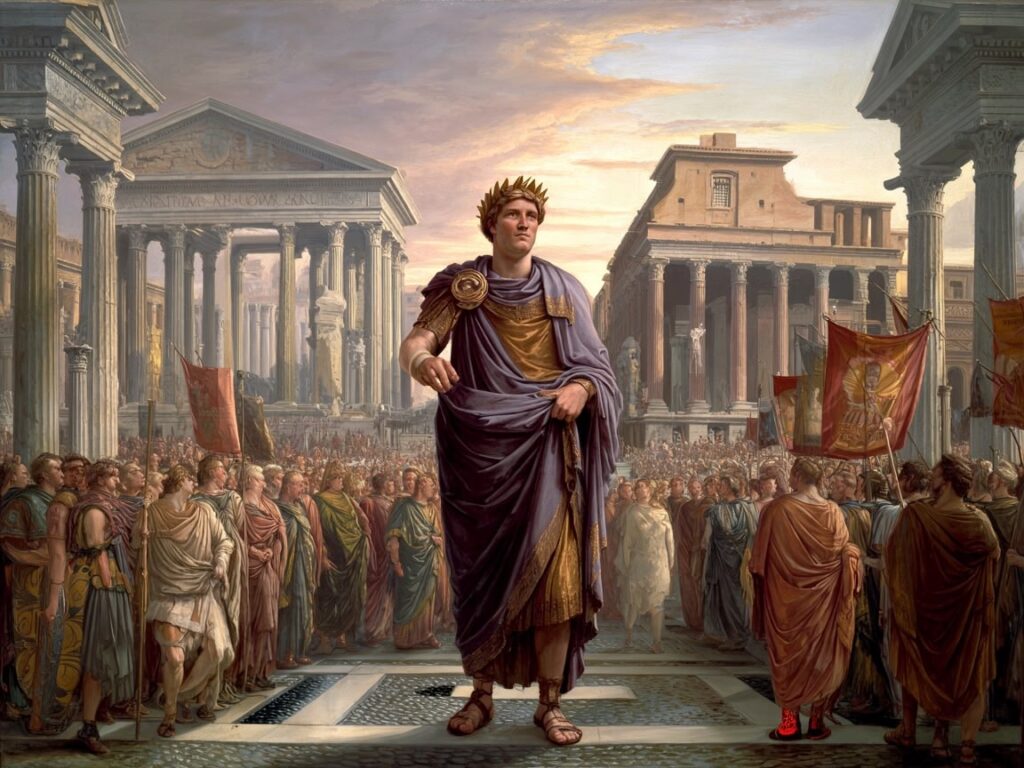
Follow the Legacies and the Costs
The legacies of Augustus divided time. Contemporaries spoke of a new age—Ludi Saeculares in 17 av. J.-C. staged a fresh cycle. Later centuries marked a “Pax Romana” that extended, in idealized form, from 27 av. J.-C. to 180 apr. J.-C. under the “good emperors.”
- An imperial constitution without a constitution. Augustus’s power became a template: tribunician power, imperium maius, pontifex maximus (12 av. J.-C.), pater patriae. Successors inherited a package of honors and authorities rather than a crown. The empire learned to reproduce sovereignty through precedent and acclamation.
- Professional armies and frontiers. Fixed legions on the Rhine, Danube, and East created military careers and identities. Long service terms bound soldiers to the state more than to temporary generals. Veterans’ colonies Romanized landscapes, Latinized towns, and wove roads into imperial sinew.
- Administrative regularity. Censuses, tax reforms, and a divided provincial map—senatorial versus imperial—brought predictable governance. Equites found careers as procurators and prefects. The bureaucracy remained thin by modern standards yet sufficient to coordinate law, roads, and commerce.
- Urban fabric as ideology. The Campus Martius displayed an urban portfolio of memory: Mausoleum of Augustus, Ara Pacis, Horologium, theaters, baths. Cities across the empire mirrored this grammar with forums, temples, and arches, integrating local pride into imperial vocabulary.
- A cultural canon. Virgil, Horace, Livy, and Ovid framed Roman identity for millennia. Even Ovid’s exile (8 apr. J.-C.) taught later readers about the costs of crossing power. Augustan classicism set standards of Latin style and moral ambition that later ages imitated and resisted in turn.
- Law and status. Marriage laws and moral legislation declared ideals even when enforcement faltered. The Lex Papia Poppaea (9 apr. J.-C.) incentivized family formation among elites. The subtext was demographic anxiety and social control. The laws shaped discourse more than behavior, but discourse matters: the state claimed interest in private virtue.
- Religious settlement and ruler cult. As pontifex maximus, Augustus curated priesthoods and rituals. The imperial cult in provinces gave a language to loyalty. Its elasticity—local forms honoring a universal ruler—allowed empire to speak many vernaculars of veneration.
Costs accompanied gains. The memory of proscriptions never fully faded. Political competition narrowed to palace and barracks. The charismatic “first man” model risked succession crises, mitigated by adoption but never solved. Yet the system endured, arguably because it coupled centralized command with distributed honors and benefits.
Even words changed. “Augustus” became a title; a month took his name. Power learned to hide in plain sight, prefacing later political arts where leaders seek legitimacy through narrative as much as through law.
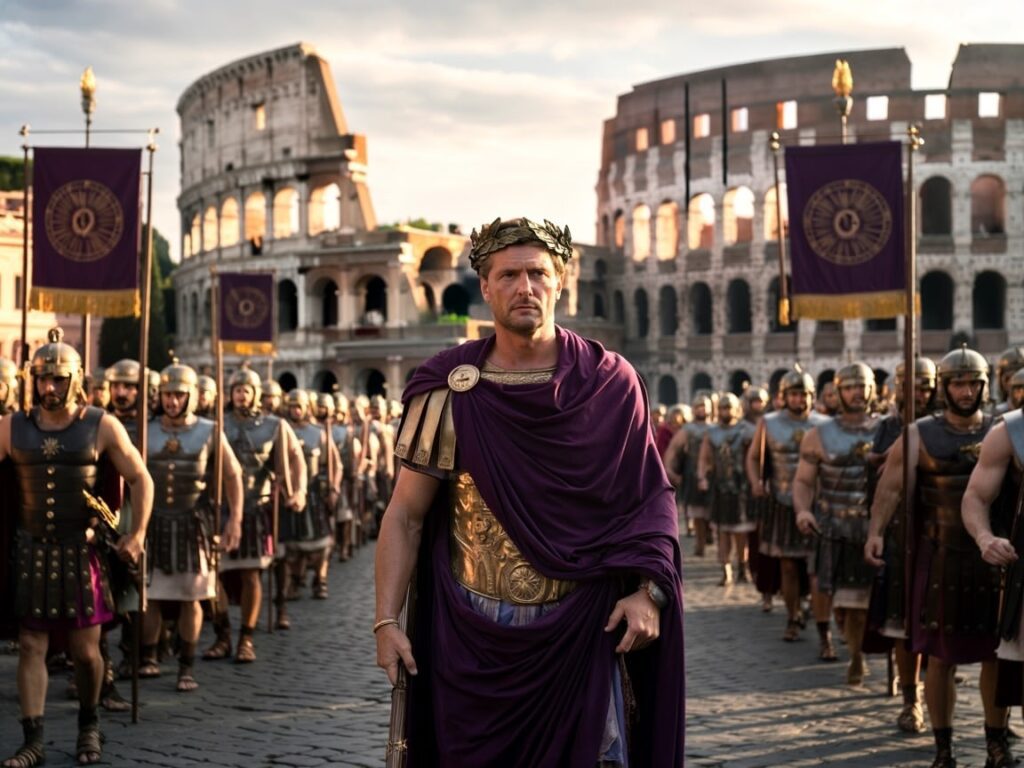
Conclude the Argument and the Arc
Octavian did not seize a throne. He authored a role that did not exist and then made it feel ancient. He achieved this by turning the resources of Rome—law, army, money, ritual, literature—into instruments of continuity after rupture. The republic he “restored” was a republic of forms; the empire he created was an empire of expectations. His genius lay in recognizing that fear of civil war was a stronger ally than any legion, that marble could teach the eye to love order, and that refusal—of crowns, of perpetual office—could be the most convincing assertion of supremacy.
Was he tyrant or savior? The question misses how he reframed the choices. After decades of chaos, many Romans accepted that freedom might now mean freedom from civil war. Augustus made that bargain legible and livable. When he died in 14 apr. J.-C., the state did not collapse; it adapted. That resilience is the final proof of his architecture. A young heir had become the master builder of Rome’s political imagination, not by abolishing the past, but by staging it until it performed a new future.
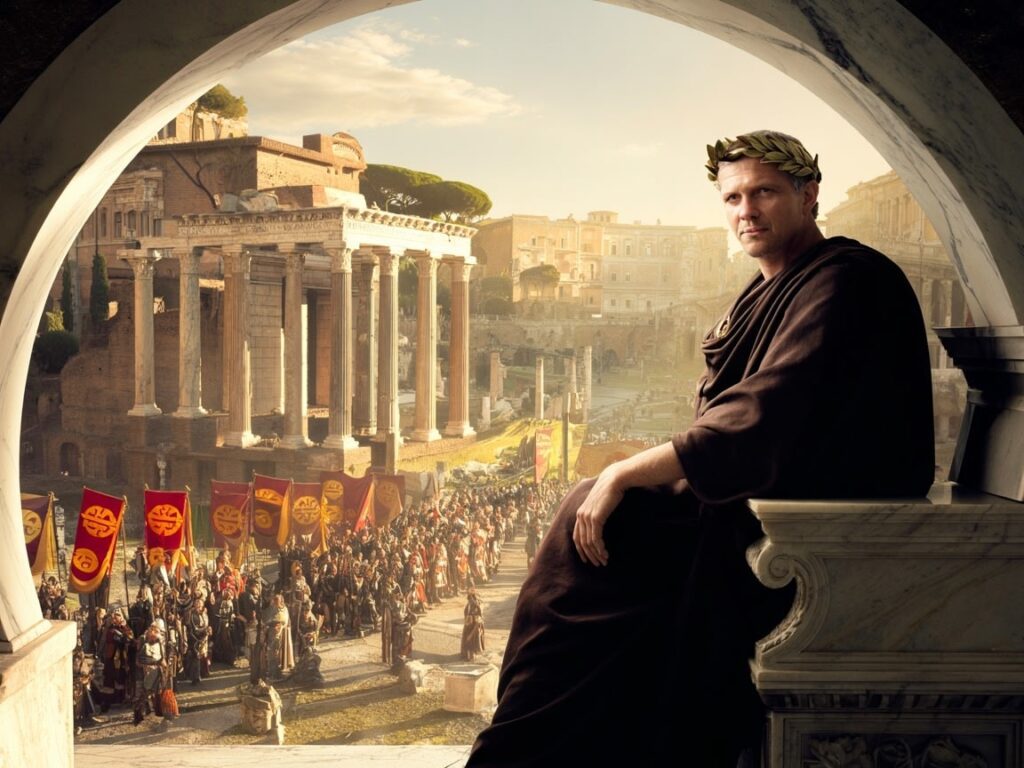
Landmarks and Lineages
- 63 av. J.-C.: Birth of Gaius Octavius.
- 44 av. J.-C.: Caesar assassinated; Octavian named heir and adopts Caesar’s name.
- 43 av. J.-C.: Second Triumvirate; proscriptions; consulship.
- 42 av. J.-C.: Philippi; defeat of Brutus and Cassius.
- 36 av. J.-C.: Naulochus; Sextus Pompey defeated; Lepidus sidelined.
- 31 av. J.-C.: Actium; Antony and Cleopatra flee.
- 27 av. J.-C.: First Settlement; title “Augustus.”
- 23 av. J.-C.: Second Settlement; tribunician power and imperium maius.
- 17 av. J.-C.: Ludi Saeculares; Carmen Saeculare.
- 12 av. J.-C.: Pontifex maximus.
- 2 av. J.-C.: Forum of Augustus; pater patriae.
- 14 apr. J.-C.: Death; consecration.
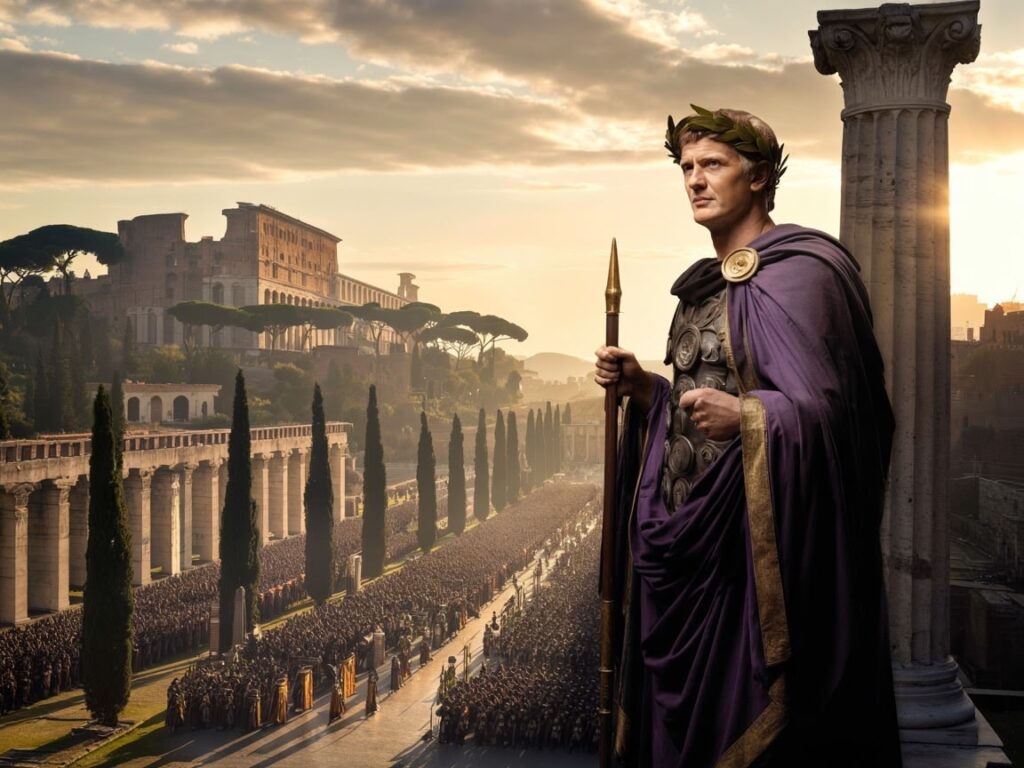
The Enduring Dispute
- “Restoration” thesis: Augustus saved Rome by reviving ritual, restraining office, and institutionalizing stability; legal settlement over personal rule.
- “Revolution” thesis: A monarchy in republican dress, built through violence and patronage; continuity as camouflage.
- Middle path: Innovations wrapped in tradition; collaboration by co-optation; consent manufactured by material benefits and cultural persuasion.
- Ancient voices mirror the divide: “I restored the republic” (Res Gestae) versus Tacitus’s acid summary of peace purchased with obedience.
- Today’s consensus emphasizes method: legitimacy via law and spectacle.
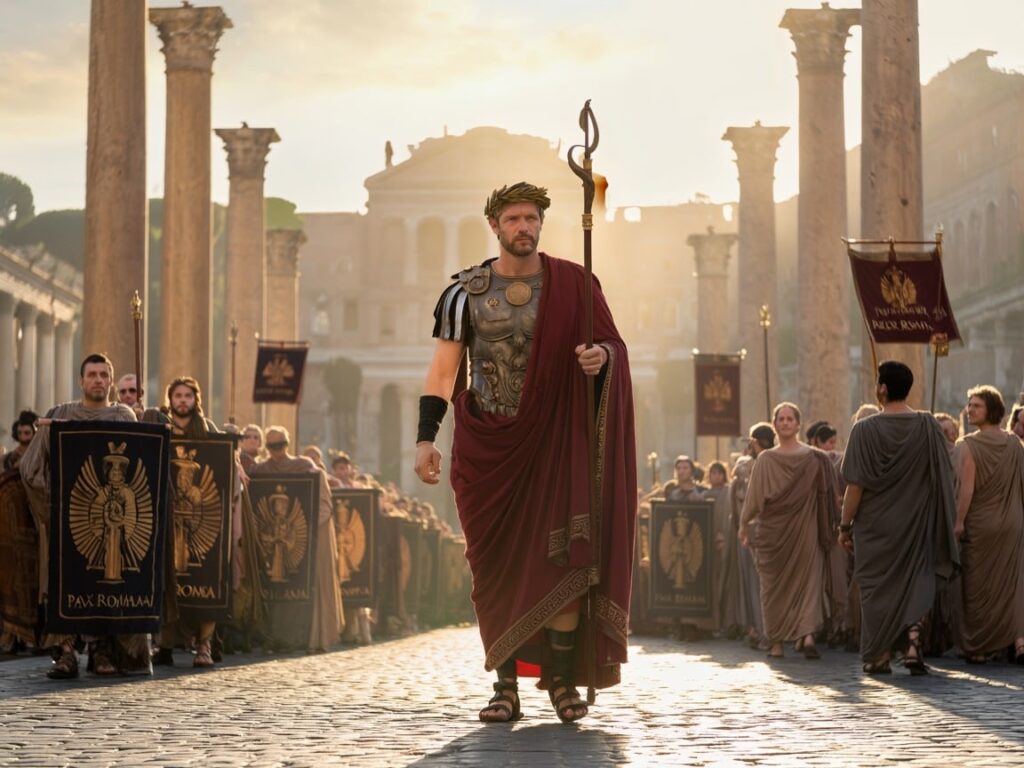
Credits and Sources
Ancient sources: Res Gestae Divi Augusti; Suetonius, Divus Augustus; Cassius Dio, Roman History; Velleius Paterculus; Tacitus, Annals I; inscriptions from the Ara Pacis; coinage showing the Sidus Iulium and Parthian standards. Poetry: Virgil’s Aeneid; Horace’s Odes and Carmen Saeculare; Ovid’s Tristia. Modern analyses: Ronald Syme’s Roman Revolution; Paul Zanker on Augustan imagery; Karl Galinsky on ideology and culture; Fergus Millar on imperial governance; Mary Beard’s reflections on ritual and interpretation. All read against archaeological and epigraphic evidence.

